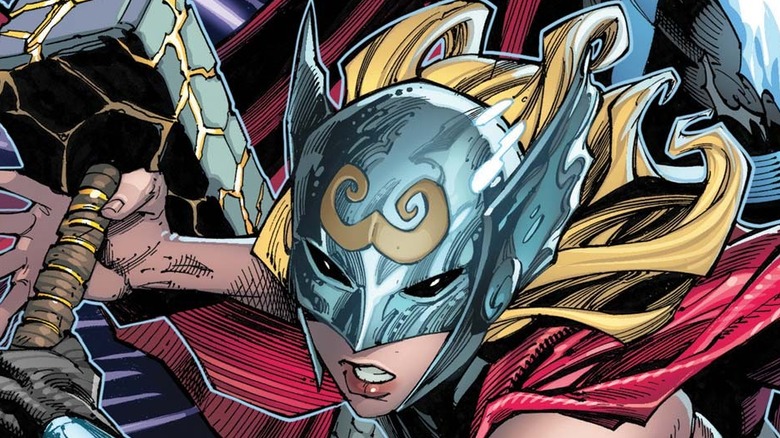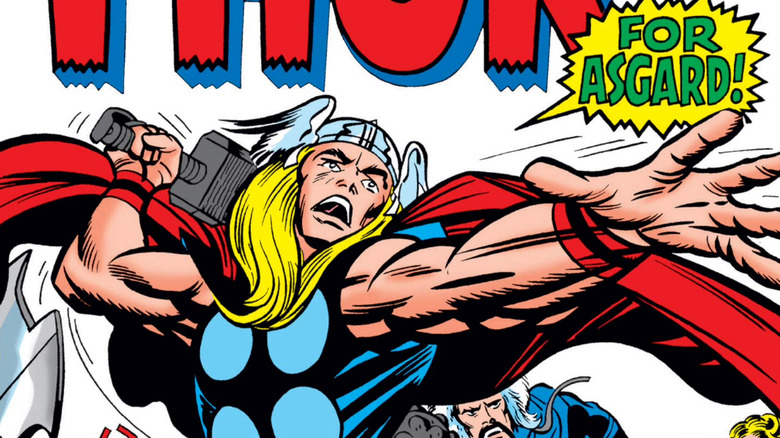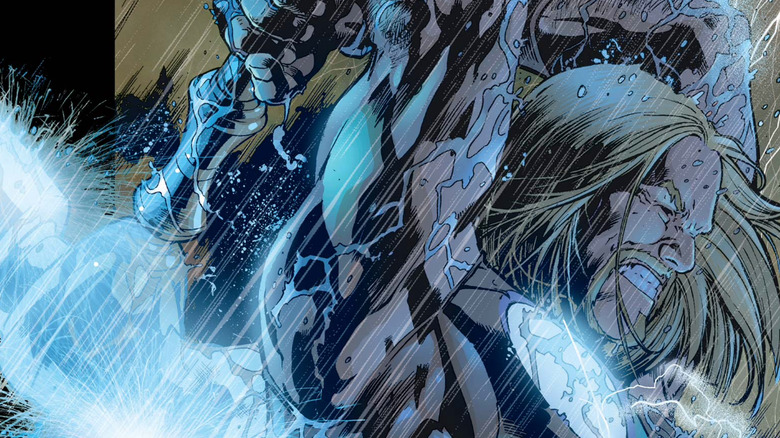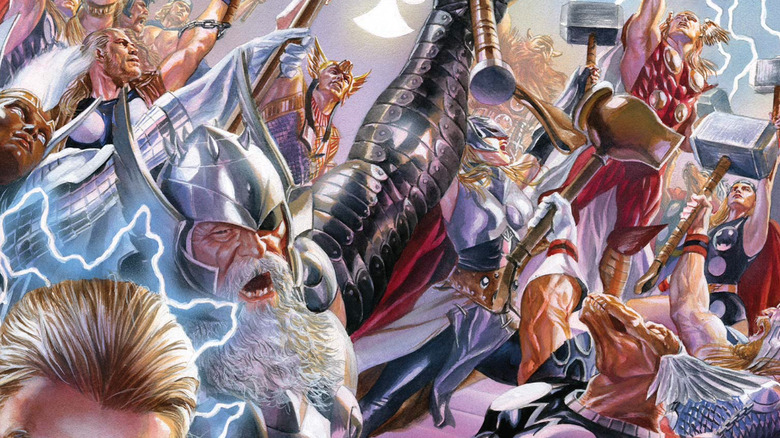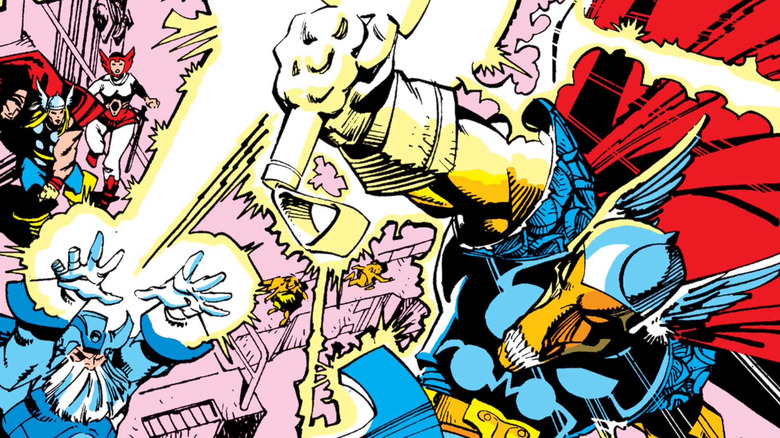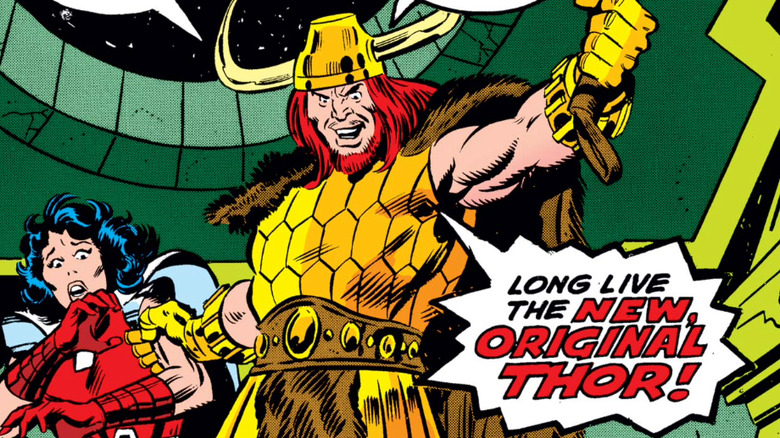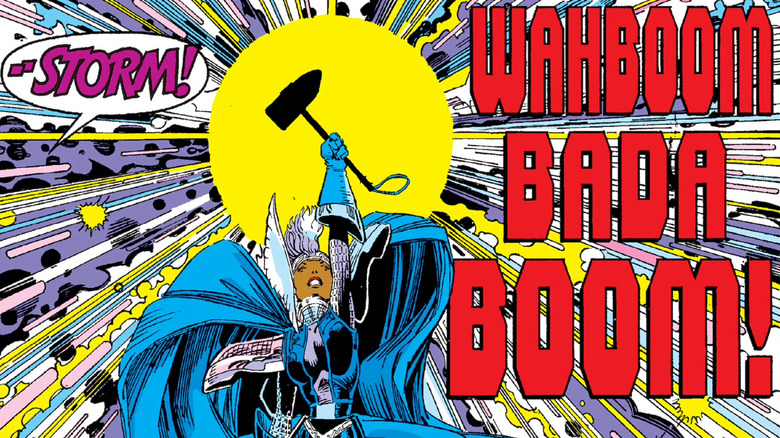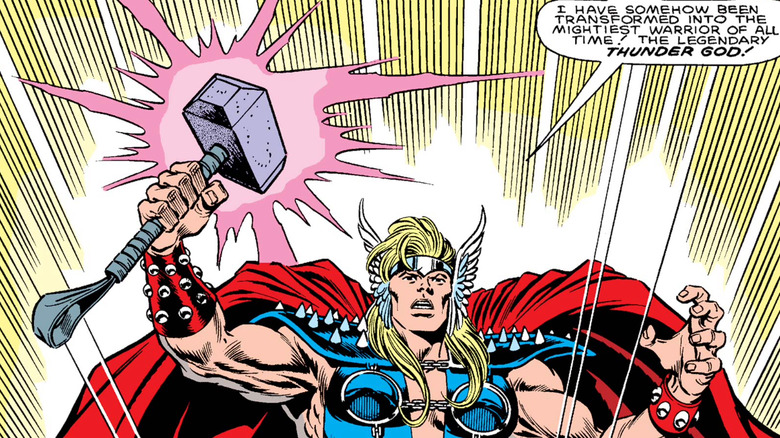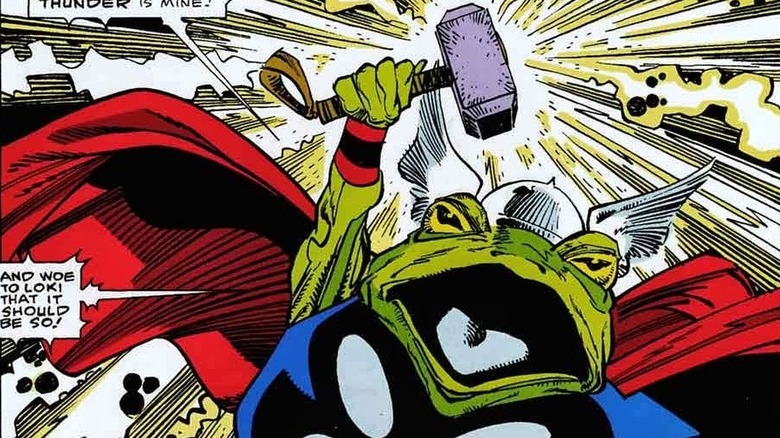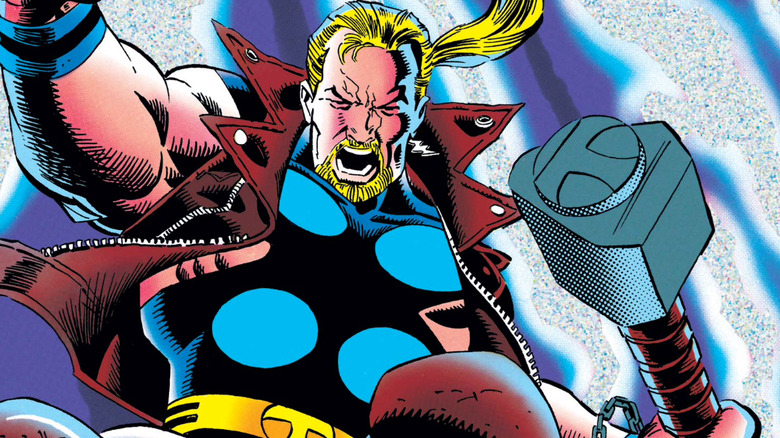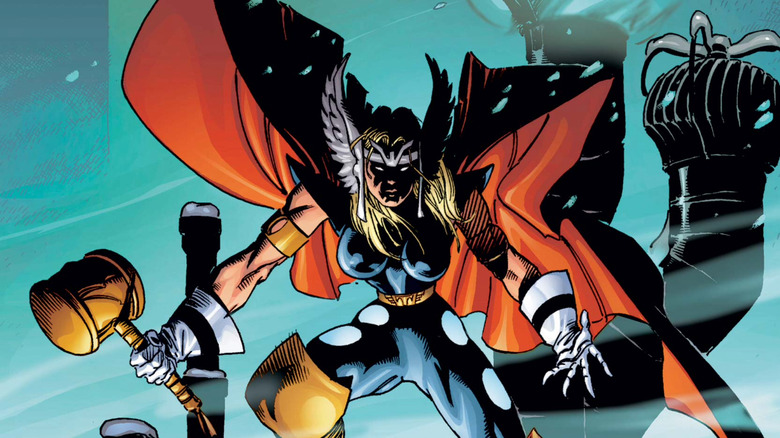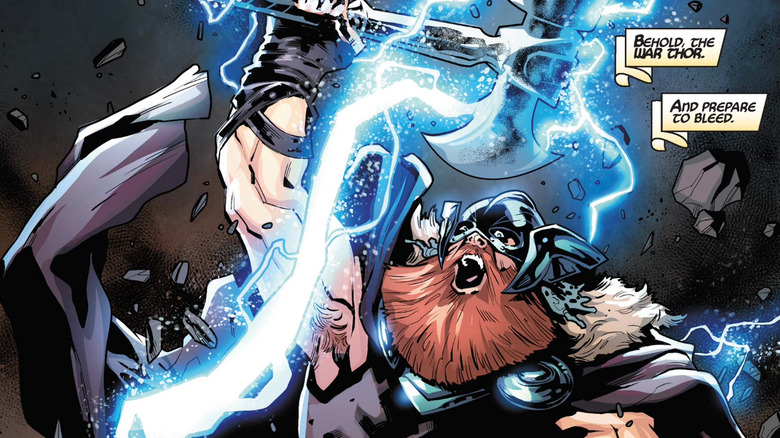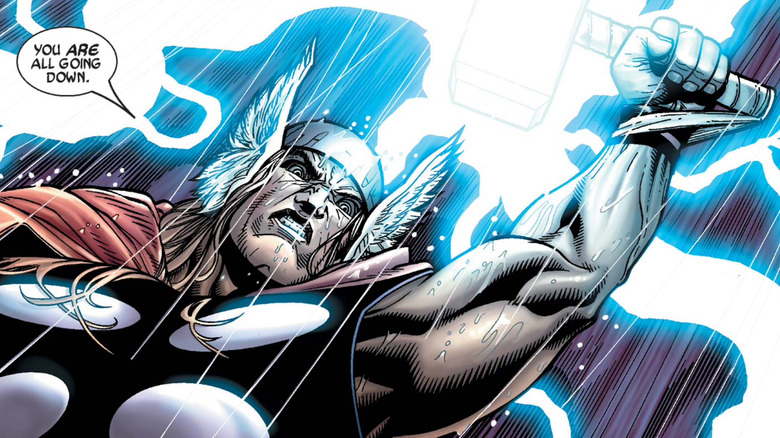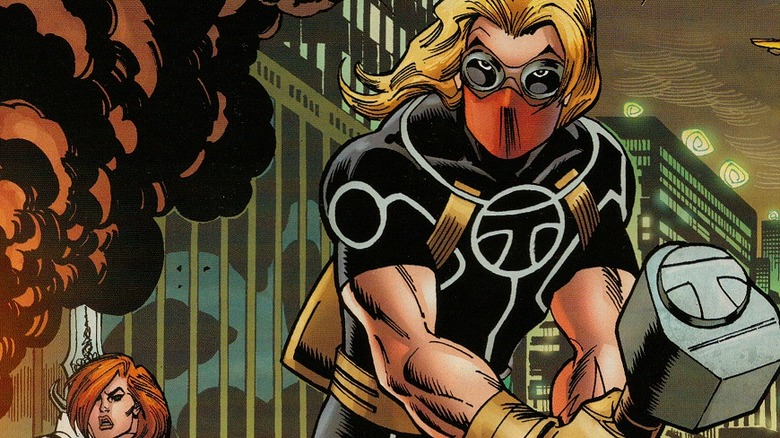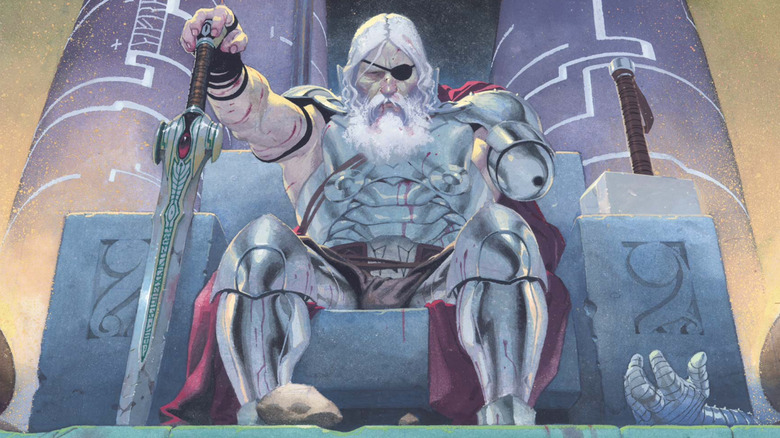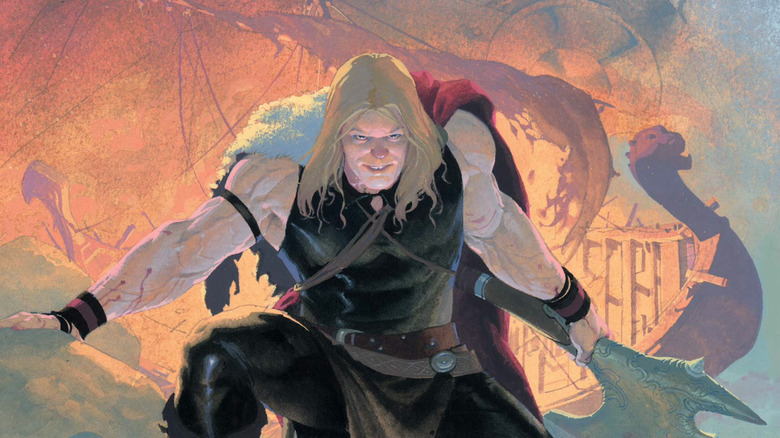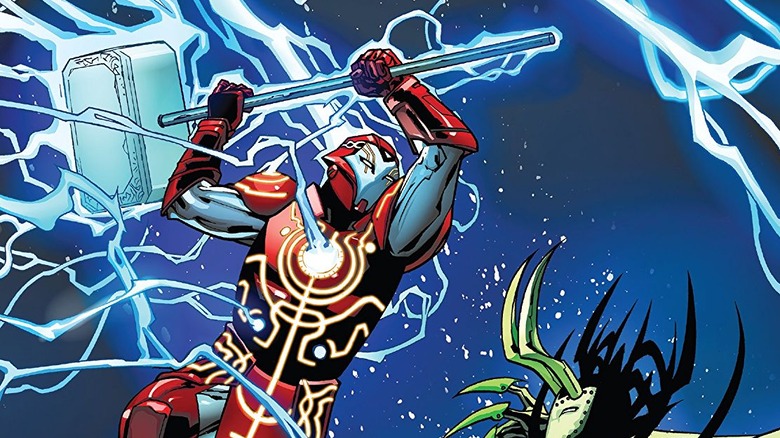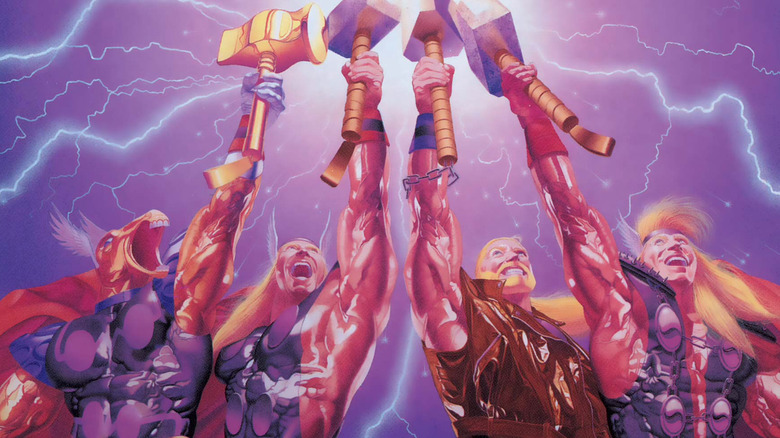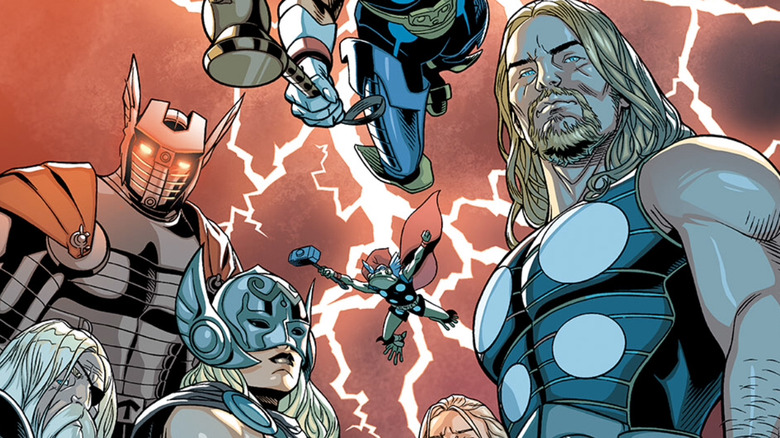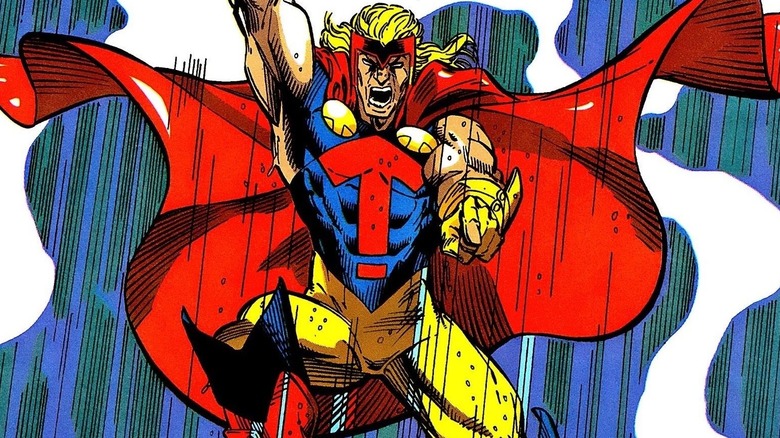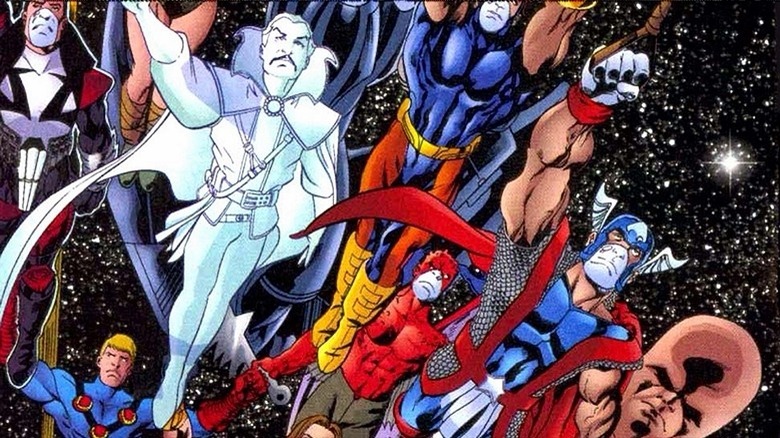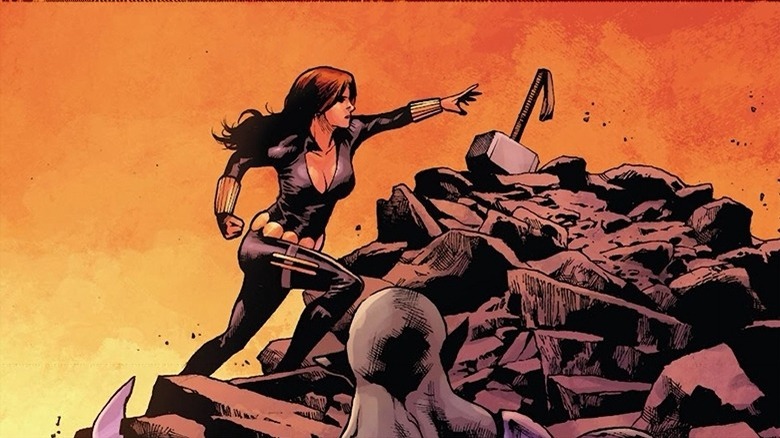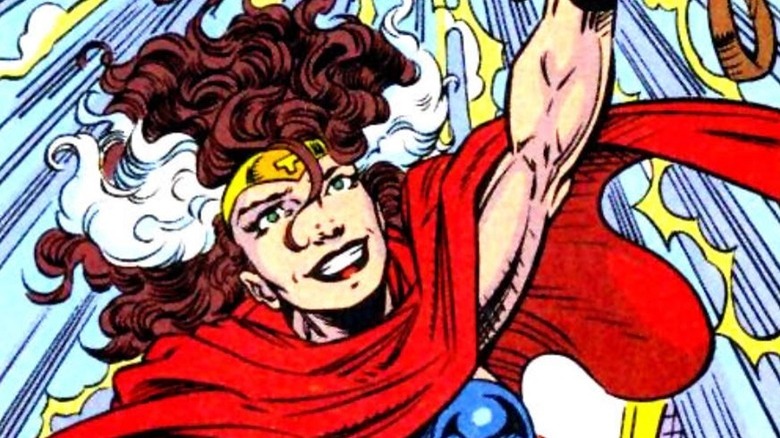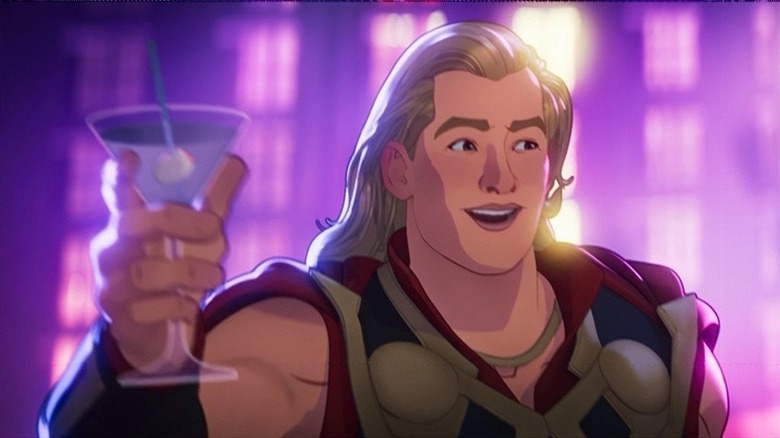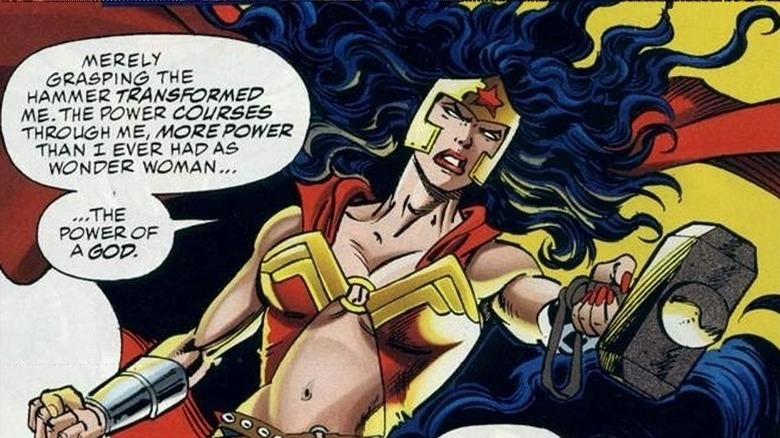The Many Thors Of Marvel
"Whosoever holds this hammer, if he be worthy, shall possess the power of Thor."
Those are the words carved into the legendary uru hammer Mjolnir, letting any candidates know that being Thor isn't for just anyone. Time and again we've seen strength alone isn't enough to wield the weapon. A person must be truly worthy of the honor.
So it may surprise you just how many different Thors have existed in the Marvel Universe. We don't mean people like Captain America — people who proved able to lift and use the hammer a number of times. We mean men and women who have spent a significant amount of time — in one way or another — living with the power and the responsibility of Marvel's thunder god, Thor. From spinoffs to alternate reality counterparts to mutants, frogs, and horse-faced aliens, here are the many Thors of Marvel.
Thor Odinson
Thor Odinson, as far as Marvel Comics is concerned, is the original. First appearing in 1962's "Journey Into Mystery" #83, he's initially the alter ego of Dr. Donald Blake, who finds Mjolnir and proves worthy to wield it. Thor and Blake can switch places by smacking Mjolnir (which appears as a walking stick in Blake's hands) on the ground. It's later revealed Blake is a construct of Thor's father Odin, and while there are a few other attempts to saddle Thor with a secret identity, for the most part, he exists solely as Thor: no quick changes in telephone booths.
Even during periods when Odinson briefly loses his powers — like the comics arc that found him unworthy to lift Mjolnir and replaced by Jane Foster — he never stays on the sidelines long. Even without Mjolnir, Odinson refuses to be anything but a hero.
The Ultimate Thor
When Mark Millar and Bryan Hitch reimagined the Avengers for Marvel's Ultimate line, their version of Thor included some of the most intriguing differences with the original.
First, when the Ultimate Thor is introduced in 2002's "Ultimates" #4, no one's sure if he really is Thor. When Nick Fury tries to recruit him into the Ultimates, Thor is a far-left activist in Norway who's published self-help books and is popular on lecture circuits. Bruce Banner calls him "a crazy ex-nurse" who was institutionalized for over a year after his revelation that he was the Son of Odin. It isn't until Ultimates' second volume that Thor's godhood is confirmed.
The Ultimate Thor is one of the many heroes lost when Marvel's Ultimate line officially closed with 2015's Ultimate End. His unique version of Mjolnir remains, however: His half-hammer, half-ax appears in Asgard at the end of 2015's Thors miniseries and has since had a significant impact on the course of events in the prime Marvel Universe.
The Mighty Thor
Natalie Portman is reprising her role as Jane Foster, who in turn will gain the power of Thor, in 2021's "Thor: Love and Thunder." And it's a development pulled right from the comics.
As a result of the 2014 line-wide event "Original Sin," Thor Odinson loses his worthiness. In that year's "Thor" #1, a female Thor takes up the hammer and fills the void Odinson leaves behind. Her identity was left a mystery for a time, but eventually Thor's former main squeeze Jane Foster is revealed to be the new hammer-wielder in "Thor" #8.
Jane remains Thor for four years. In 2018's "Mighty Thor" #705, she's forced to sacrifice Mjolnir in order to defeat the monster Mangog, thus losing the power of Thor. More recently, at the conclusion to 2019's "War of the Realms" event, Jane replaces not Thor but Valkyrie in the ongoing series "Valkyrie: Jane Foster."
Beta Ray Bill
Walt Simonson's "Thor" run remains one of the most well-remembered tenures in Marvel Comics, and one of his landmarks was the surprising introduction of the horse-faced hero Beta Ray Bill who proves himself worthy of the power of Thor.
In 1983's "Thor" #337, Thor intercepts a spaceship at Nick Fury's request, and its pilot turns violent. During their clash, Bill lifts Mjolnir, only seeking to use it against Thor. Odinson and Bill eventually work things out, and Odin decrees that since Bill has proven himself worthy, he and Odinson must fight for Mjolnir's possession. Bill wins the fight, but refuses to take Odinson's hammer. Instead, Odin has the dwarves of Nidavellir create a new hammer, Stormbreaker, for Beta Ray Bill.
Bill remains one of Marvel's most powerful heroes and has served as part of a recent incarnation of the "Guardians of the Galaxy."
Red Norvell
In 1978's "Thor" #276, cameraman Roger Norvell, with Loki's help, captures Thor Odinson's belt of strength and iron gloves, allowing him to become a new Thor capable of wielding Mjolnir. The new red-haired Thor seems more villain than hero at first — harboring an unhealthy obsession with Sif and beating the hell out of Odinson — but eventually proves himself worthy of the title when he sacrifices himself to save Asgard two issues later.
But that isn't the end of Red Norvell. He earns a spot in Valhalla for his sacrifice, and 16 years and 200 issues later, Odin resurrects him in "Thor" #478 to replace Odinson, who Odin feels is neglecting his duties to Asgard.
Since then, Red Norvell has essentially been in limbo, last seen in 1997's "Journey Into Mystery" #513. There were rumors of his return in the "Asgardians of the Galaxy" series, but they didn't pan out.
Ororo, Goddess of Thunder
In "The Asgardian Wars," stretched across 1985's "New Mutants Special Edition" #1 and "X-Men Annual" #9, Loki tempts Storm of the X-Men by giving her what seems to be the power of Thor. When Storm's friends arrive on Asgard to save her, Loki's magic makes them all appear as enemies.
Loki crafts a powerful hammer for Storm. While there could be plenty of debates about how its power compares to Mjolnir's or Stormbreaker's, Ororo nearly kills Wolverine with its magic and gives Hela a run for her money. Eventually, Ororo sees through Loki's magic and relinquishes her power, knowing that keeping it would mean being Loki's puppet.
Though she gives up her power, "The Asgardian Wars" isn't the last appearance of this particular goddess of thunder. She's shown to still have access to that power in 2018's "X-Men: Gold" #26.
Dargo, Thor of the 26th century
Ever wonder what Marvel's Thor would look like in a "RoboCop" or "Total Recall"-esque dystopian future? If so, check out 1987's "Thor" #384, where the very heavy metal Dargo Ktor is surprised to be transformed into a much spikier version of our hero.
In the 26th century, a massive corporation called Corp rules over the Earth. Dargo is a member of the secretive Cult of the Hammer which somehow manages to locate Mjolnir, though he doesn't believe in stories of thunder gods. When Loki uses the forces of Corp as well as his own troll underlings to assault the Cult, Dargo reaches out blindly for a weapon, grasps Mjolnir's handle, and proves worthy.
Dargo's adventures in the future aren't the end for him. He appears again a few times, helping heroes from the present day, including as a member of the original Thor Corps.
Throg, Frog of Thunder
Remember in "Thor: Ragnarok" when Thor tells Bruce Banner and Valkyrie a story about Loki turning him into a frog? Well, that actually happened in the comics. At the very end of 1986's "Thor" #363, a disguised Loki turns his half-brother into a frog. Thor remains froggy for a few issues, becoming Throg, Frog of Thunder.
In 2009, a new Throg emerged. In 2009's "Lockjaw & the Pet Avengers" #1, we meet Simon Walterson (a blatant reference to legendary "Thor" writer/artist Walter Simonson), who's cursed by a witch and becomes Throg full time. He's gained some popularity since then. You can croak fear into the hearts of your enemies as Throg in "LEGO Marvel Super-Heroes 2," and the amphibian hero has his own story in 2017's landmark issue "Mighty Thor" #700. More recently, Throg kicked interstellar butt as the tiniest member of the Asgardians of the Galaxy.
Eric Masterson, a.k.a. Thunderstrike
For a time, Thor maintained the secret identity Sigurd Janson, whose closest circle of friends included Eric Masterson. In 1989's "Thor" #408, Odinson begs his father to save the life of Masterson, who was fatally wounded by the villain Mongoose. Odin solves the problem by using his magic to merge Thor and Eric together.
When they are eventually separated, because Eric has proven himself worthy of Mjolnir, Odin creates the mace Thunderstrike for Eric, granting him abilities comparable to Thor's. Eric names himself Thunderstrike after the mace. Unfortunately, although he enjoyed his own solo title for a couple of years, Thunderstrike ultimately makes the mistake of using a weapon called the Bloodaxe and is possessed by its power. In 1995's "Thunderstrike" #24, Eric regains control of himself long enough to make the ultimate sacrifice in order to defeat the Bloodaxe.
Thor Girl
A decade before Jane Foster proved worthy, there was Thor Girl.
Thor Girl's real name is Tarene, and she didn't lift anything to prove herself worthy. Tarene is an alien gifted with cosmic powers whose coming was foretold billions of years ago by an alien sorcerer. She uses her abilities to turn herself into an Asgardian goddess in 2001's "Thor" #33. For a time, Thor Girl acts as Odinson's ally, but she eventually loses most of her power in battle with the demon Surtur.
Tarene then remains on the periphery of the Marvel Universe for a bit — becoming a part of the government's Initiative project during "Civil War" and even battling the Hulk and his Warbound in the 2007 event "World War Hulk." Thor Girl is last seen during a later event, "Fear Itself," during which she grows tired of humanity and leaves Earth for spaceways.
Volstagg, a.k.a. War Thor
After the events of 2015's "Secret Wars," the Ultimate Thor's version of Mjolnir appears in Old Asgard. Odinson — at this point replaced by Jane Foster as Thor — initially seems to want to retrieve the weapon for himself in the miniseries "Unworthy Thor," but eventually decides the hammer isn't for him. We learn in "Mighty Thor" #20 that Volstagg — the large, red-haired member of the Warriors Three — takes up the hammer instead, and becomes the War Thor shortly after he's traumatized when he fails to save a group of children from a fire demon.
Volstagg's time as the War Thor does not go past the War of the Realms. When he tries and fails to stop the monster Mangog in 2017's "Mighty Thor" #701, the beast crushes the Ultimate version of Mjolnir and leaves Volstagg bleeding and helpless.
Ragnarok
The third issue of "Civil War" ends with a bit of a shocker — Thor, who had been missing and presumed dead, appears on the last page seeming ready to do some damage to Captain America and his band of anti-registration heroes. In the following issue, he does as expected, including killing Bill Foster, a.k.a. Goliath. Later in the issue, we learn this is not Thor but a cyborg clone of the thunder god. The mythic warrior Hercules crushes the clone's head with his own hammer in "Civil War" #7.
The clone awakens in 2009's "Avengers: The Initiative" #21 and, after learning his origins, renames himself Ragnarok. He spends some years as a villain, recruited into the villainous Green Goblin's, a.k.a. Norman Osborn's, team of Dark Avengers, but he eventually joins the Thunderbolts. He was last seen in 2013's "Dark Avengers" #190 on a mission with his teammates on an alternate Earth.
Kevin Masterson, a.k.a. Thunderstrike
While Eric Masterson, the original Thunderstrike, has the relatively unique honor of being a dead Marvel hero who remains in the grave, his end was not the end of Thunderstrike.
After his death, Eric's mace is left in the hands of the Avengers. In 2010's "Thunderstrike" #1, Captain America gives the mace to Eric's son Kevin. Kevin is disappointed when picking up the mace initially doesn't transform him. But later in the issue, after using the weapon to try to pry civilians loose when they're pinned under a car, Kevin experiences the same transformation his late father used to.
After a short solo series Kevin joins the young "Avengers Academy" heroes, fighting alongside them in the 2011 line-wide event "Fear Itself." More recently, the second Thunderstrike is seen joining the ranks of the Asgardians of the Galaxy.
King Thor
When Jason Aaron began his tenure writing Thor in 2012's "Thor: God of Thunder" #1, he introduced a Thor from the distant future.
Often appearing more like Odin than Thor, King Thor has one eye, one arm, and little patience for his younger counterparts. He joins the Thor of the present and that of the past to help defeat the God Butcher, and later reunites with them in the 2019 event "War of the Realms." The curmudgeon remains a constant throughout Aaron's tenure on "Thor" – often appearing alongside a future version of Wolverine who has possessed the Phoenix Force — and we eventually see the Thor of the present suffer the wounds that are old news to King Thor.
In late June 2019, Marvel announced Aaron would conclude his time writing Thor with the four-part miniseries "King Thor," focusing primarily on the Odinson of the future.
The young Thor
Thor wasn't always worthy of Mjolnir and just as he's shown us the adventures of King Thor, Jason Aaron gave us plenty of glimpses into the past to a younger, less humble (if you can imagine it) and much more foolish version of Thor. Impatient for his chance with the hammer, the young Thor is often seen testing his ability to lift Mjolnir, only to curse at it when he fails.
Without Mjolnir, the younger version of Thor carries the powerful ax Jarnbjorn. The ax, unfortunately, can't grant Thor the gift of flight like Mjolnir, so instead, he rides a chariot pulled by his two flying goats Toothgnasher and Toothgrinder.
Like King Thor, this younger, ax-wielding Odinson aids the present-day Thor both in his battle against the God Butcher and his final conflict with Malekith in "War of the Realms."
Iron Hammer
In the 2018 Marvel event "Infinity Wars," a separate universe is created in the Soul Stone whose inhabitants are the combination of pre-existing Marvel characters. For example, the origins and powers of Ghost Rider and the Black Panther are combined to create the Ghost Panther. Spider-Man and Moon Knight become the Arachknight. Likewise, the stories of Iron Man and Thor merge to become that of Stark Odinson, the Iron Hammer.
Fittingly, almost all of the villains, friends, and lovers of both Thor and Iron Man are combined to create the cast of Iron Hammer's stories. The Iron Man villain Madame Masque and Hela, the goddess of death, are combined to make Madame Hel. The dark elf Kurse and the Russian villain Crimson Dynamo come together as the Krimson Kurse.
Iron Hammer was last seen in 2019's "Secret Warps" event, along with the other patchwork heroes of his universe.
The Thor Corps
As you can likely tell, these days it isn't that rare for a handful of different people to simultaneously call themselves "Thor" or at least to claim some of his power. But in 1993 it was relatively novel, and Marvel took advantage of the situation to launch the miniseries "Thor Corps."
"Thor Corps" unites Thor Odinson, the alien Beta Ray Bill, the original Thunderstrike, and Dargo the 26th century Thor all in one team. The four embark on a dimension- and time-hopping adventure which sees them saving reality itself and battling villains and heroes from all over the multiverse.
It would be over two decades before the phrase "Thor Corps" became regularly heard in comic book vernacular again, and this time it was a very different group of Thors with a much larger roster.
Thors
In the 2015 event "Secret Wars," Doctor Doom creates a patchwork planet called Battleworld with alternate reality versions of different characters sharing the same planet. For his police force, "God" Doom creates a new version of the Thor Corps, which includes hundreds of Thors from across the multiverse. There are familiar characters like the Ultimate Thor and Beta Ray Bill alongside tons of new versions like a Gamora Thor, a Lizard Thor, and even a Groot Thor who says only "I am Thor."
The Thors show up in most of the series attached to "Secret Wars," though they take center stage in the miniseries "Thors," during which the Ultimate Thor investigates a string of serial murders of different Jane Fosters across Battleworld.
"Thors" ends with the Thor Corps joining the battle against God Doom, the death of the Ultimate Thor, and the Ultimate Mjolnir appearing in Old Asgard.
Cecil McAdam, a.k.a. Reverend McAdam
On Earth-928, in the year 2099, Thor is worshipped once more. Thor, along with his fellow Asgardians, left years earlier in response to the corporation Alchemax stoking anti-hero rage. Those who couldn't escape to different worlds either ended up dead or quit being a hero. The Church of Thor and its followers — Thorites — wait anxiously for the return of the God of Thunder.
However, unbeknownst to the Thorites, Thor and nearly all other Asgardians had already been killed. Alchemax had followed the gods back to Asgard and, through trial and error, successfully developed weapons capable of slaying the gods. Only Loki survived by running and hiding.
In "Punisher 2099" #13, Alchemax plays upon this lack of knowledge by engineering its own Asgardians to act as the true gods returned to Earth. Cecil McAdam, a janitor at the Church, willingly allows the corporation to turn him into their version of the Thunder God. While McAdam is genuinely motivated by a desire to be heroic, his corporate masters use him to distract from their dark dealings and eliminate the steadily increasing number of costumed heroes kicked off by the new Spider-Man 2099, Miguel O'Hara. When separated from the source of his power, his hammer, McAdam chooses to chase into an explosion, seemingly dying, rather than return to an ordinary life.
Captain America 2099
The Marvel 2099 universe was not truly done with Thor yet, however. In an echo of his Silver Age return, Captain America was once again discovered in a block of ice after years of being assumed killed in the superhero purge. Alchemax, now led by O'Hara and struggling to undo its history of illegal and immoral activities, located the true hammer of Thor, Mjolnir, around the same time.
As in the films and the comics, Steve Rogers proves worthy and is able to hoist the hammer, becoming a heroic Thor for the era. Together with Spider-Man and a league of other heroes in "2099: Manifest Destiny" #1, the two begin to repair the fallen world of 2099. While the one-shot story marks the end of the 2099 line — for the time, at least — it sends the universe off on an upbeat note. After being a dystopia for nearly the entirety of its existence, the return of Captain America, becoming Thor, and joining with Spider-Man implies that, for the first time, the era might genuinely have a chance to improve life for all. Captain Thor's last act provides a catalyst for what should be better days to come.
Black Widow
Marvel has typically depicted Ragnarok, the Asgardian Apocalypse that resets Thor and his fellow gods' reality, as a localized event. Readers have watched the event destroy Asgard and the deities several times, all without doing much damage to Midgard, aka Earth.
In "What If? Age of Ultron" #3, however, Earth is not spared. After slaying Thor and destroying Asgard, the monstrous serpent Jormungand does not stop. Instead, it targets Earth's Mightiest Heroes, killing scores of Avengers. Soon only a handful of heroes still live, including Falcon, Shang-Chi, Nick Fury, and Black Widow. The small team decides to take on the world-destroying serpent despite the incredibly bad odds. They will almost certainly die, but at least they'll go out fighting for humanity.
However, their boldness pays off. By taking the fight to Jormungand, the team ends up in a position to find Mjolnir amongst the rubble the serpent has left in its wake. Without expectation, Black Widow grabs Thor's abandoned hammer. Defying expectations, Natasha has evidently been made worthy by her time fighting to forestall the end of humanity. She can hoist the hammer skyward and become the new God of Thunder. Combining the power of a god with her gift for strategy and capacity for ruthlessness, Black Widow joins the battle. While the book only briefly shows her efforts, Fury's narration confirms that the spy turned superhero turned god indeed carried the day, and rather spectacularly at that.
Rogue
The X-Man Rogue has been a fan favorite for so long that newer readers might not recall that, for years, she ran with villains like Mystique and the Brotherhood of Evil Mutants. During that time, she even took on Carol Danvers. Then calling herself Ms. Marvel, Danvers found herself quickly overwhelmed by Rogue, who permanently absorbed the hero's abilities, like flight and super strength.
"What If...?" #66, "What If... Rogue Possessed the Powers of Thor," took readers back to this era of Rogue's life. After breaking out of prison with her fellow members of the Brotherhood, the mutants find the Avengers ready to put them back in their cells. In an echo of her fight with Carol, Rogue absorbs Thor's powers. The God of Thunder, however, does not fare as well as the future Captain Marvel. He falls into a coma and dies soon after.
Now permanently possessing the powers of a god, Rogue briefly falls into cahoots with Loki. Persuading her to help him kill his adopted father Odin, the God of Mischief mounts a rebellion. He sends Rogue and his troops to invade Asgard. When things look at their most desperate, however, Thor approaches Rogue on the astral plane. He convinces her that, regardless of her past, she can be a hero. Realizing the truth of his words, Rogue accepts her new role as Goddess of Thunder, routs Loki's forces on Midgard and Earth, and gains acceptance from the gods and the Avengers.
Thor the only child
In the Disney+ animated series "What If...?," the series' seventh episode of Season 1 puts Thor in the starring role. The installment, called "What If... Thor Were An Only Child?," sees the God of Thunder turned into an immortal partier who can nonetheless wield his hammer. Without Loki to both make his life miserable and inspire him to protect others, Thor has lived a charmed life devoid of consequence or responsibility. He's a charming but reckless moron who hops planet to planet throwing such bashes so intense they end up ravaging the world. And now, he's arrived on Earth.
However, things finally start to change thanks to a combination of Jane Foster helping him see the value of humanity and Captain Marvel's being strong enough to keep the God of Thunder's destructive impulses focused on her rather than casually decimating the world. In the end, the heroes of Earth, including Nick Fury, manage to save the planet in a way both silly and logical. How do you stop a man-child in his tracks? Well, you call his mother, of course.
Wonder Woman
Yes, DC characters can, evidently, be worthy of Mjolnir. And not just Superman, either. During the blockbuster DC versus Marvel (or Marvel versus DC, depending on the issue) event, cosmic forces pitted heroes from both universes against each other. The characters had no choice but to engage in solo fights for the fate of their worlds.
After Thor loses his hammer during a fight, Wonder Woman comes across Mjolnir. She is able to lift it and quickly absorbs the powers of the God of Thunder, emerging from the lightning in a new costume, ready for a fight. Puzzlingly, however, when her chosen opponent, the X-Man Storm, arrives, Wonder Woman quickly discards the hammer in the name of a fair and honorable fight. And promptly gets wrecked by the mutant.
Considering she is fighting for the DCU's existence, it seems odd that Wonder Woman would so quickly cede an advantage. However, the crossover was based on fan voting, so perhaps the creators felt it was far too unrealistic to give Storm her fan-affirmed victory over Wonder Woman when the Justice Leaguer had both her power and Thor's.
